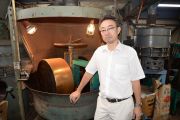In Japan’s Inland Sea, Awaji Island produces some of the world most refined incenses. A few shops sell them in France.
[ Practical ]
Getting to Awaji
- Air France, ANA and Japan Airlines flights to Osaka Kansai Airport
- Bus, train or ferry from Osaka Kansai Airport to Kobe Sannomya
- Bus to Awaji from Kobe Sannomiya bus station
Accommodation in Awaji
- Parchez hotel, restaurant and spa
Tel : 00/81-799851162
www.parchez.co.jp
Where to buy Awaji incense in France
- Astier de Villatte : 173 rue Saint-Honoré, 75001 Paris
- Nose, 20 rue Bachaumont, 75002 Paris.
- Musée Guimet and Musée du Quai Branly gift shops
- Several websites specialized in incense or Japanese products
Before saying you don't like the smell of incense, try the ones produced on the Japanese island of Awaji, near Kobe. Giving off refined, elegant and complex scents, they have nothing to do with the cheap incense with heavy and heady smell sold in any oriental shop.
Awaji’s producers are the heirs of a long tradition dating back to the sixth century. When the locals found agar wood stranded on a beach.
 Thirty manufacturers Thirty manufacturers
Ignoring what it was, they used it to make a fire and thus discovered with amazement its odorous properties. They immediately donated it to the Emperor initiating the use of incense in the Land of the Rising Sun. Origins recalled by two temples, one located above this beach.
However, the production of incense was quickly transferred to Sakai, near Osaka, closer to the imperial capitals of Nara and Kyoto, and it was in this city that incense sticks and spirals were invented. Previously it was shaped like a cone and simply carried on oneself, in a small pouch.
But, at the end of the 19th century, a reversal of the situation took place and production returned to Awaji where the dominant winds favour its drying.
Some thirty manufacturers are located in the fishing port of Ei and the nearby village of Gunge, where the smell of incense is ubiquitous and varies from street to street.

 Chosaku Shimomura © T.Joly Chosaku Shimomura © T.Joly
|
 Masters of Incense Masters of Incense
Depending on their more or less sweet or spicy scents, specialists recognize with closed eyes which Koh-shi, or Master of Incense, has concocted them. This title is only granted to people who master to perfection the characteristics of all possible ingredients and all processing techniques. Like the "noses" working for perfume factories.
Everyone has their own manufacturing secrets, but also and above all their own fragrances whose compositions are preciously preserved in the form of coded writing transmitted from generation to generation. "My father didn't reveal it to me until I decided to take over and only one other member of our family knows it too, for safety," said Chosaku Shimomura, director of Daihatsu company.
He claims to have about 80 formulations. Half comes from his grandfather, a third from his father while the others are his own creations.
 A mix of twenty ingredients A mix of twenty ingredients
"I think about new one every day but it is very difficult to find the right balance between the different components to have a quality incense and I do not release more than one new fragrance per year".
Each one is the result of a subtle and skilful dosage between about twenty ingredients and Chosaku Shimomura uses more or less frequently a hundred different ones. Resins, gums, wood, bark and dried plants such as Borneo camphor, agar wood, sandalwood, cade juniper, cedar, cardamom, cloves, cinnamon, lemongrass, vetiver, patchouli and so on.
As for the manufacturing process, it has barely changed over the centuries, is partly done manually and machines in use are decades old. After being turned into powder, wood, resins, bark and other dry materials are mixed with water as well as dye for incense of a shade other than brown.
 Incense matches Incense matches
The whole is kneaded for a few tens of minutes until obtaining a paste with a clay-like consistency then moulded or extruded to give cones, spirals and sticks. After drying for 24 hours they are ready to be packed.
However, respecting traditions doesn’t mean immobility and the producers of Awaji also innovate. In partnership with a matchmaker, Chosaku Shimomura has created incense matches that you simply strike to light them. Called Hibi, they come in different fragrances and last for about ten minutes.
Don’t worry, no need to go to Japan to discover, enjoy and buy these high-end incenses. They are available in a few Parisian stores and sold on their website.
June 15, 2020
Thierry Joly 

|



